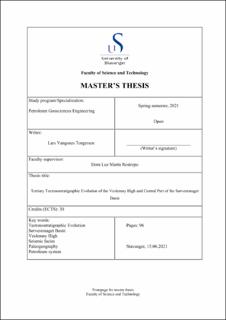| dc.description.abstract | Previous geologically works in Sørvestsnaget Basin and Veslemøy High region, suggest that
Tertiary reservoirs in the western Barents Sea are promising, but not yet properly understood
laterally, with the influence of regional and local tectonics. This thesis focuses on understanding
the lateral and vertical variation of the Tertiary succession, and how the tectonics influenced
the deposition of reservoirs, using 2D and 3D seismic data, together with provided well logs.
A major and thick Tertiary succession is present in the western Barents Sea in areas such as
Sørvestsnaget Basin. The Paleocene and Eocene seismic units are influenced by normal faulting
and rifting tectonics in Sørvestsnaget Basin, while the seismic units over Veslemøy High were
deposited in a less tectonic active period, especially in Paleocene, before a major uplift event
affected this high during the Eocene. At the western margin of the Sørvestsnaget Basin, a
marginal high was uplifted, probably time equivalent to the uplift of Veslemøy High during
Eocene, but at a significantly smaller scale. Major depocenters were present in Sørvestsnaget
Basin due to salt mobilization of a major salt diapir in the south eastern margin of the basin,
triggered during Eocene. Possible reactivation is suggested by depocenters. Glacial isostasy
from the Pliocene have led to further uplift and subsequently subsidence, causing the
accumulation of a large clastic erosional glacial wedge deposited in the generated
accommodation space, mainly Sørvestsnaget Basin.
Normal faulting, together with uplift (marginal high, Veslemøy High and the salt diapir) and
subsidence events have greatly affected the Tertiary succession, and routed/deflected the postEocene (post rift) deposits and localized them into preferential areas in Sørvestsnaget Basin,
situated in the western Barents Sea. Syn kinematic wedges are found to be controlled by normal
faulting in Sørvestsnaget Basin and at the bounding fault between the Sørvestsnaget Basin and
the Veslemøy High, in Paleocene to Eocene. Turbiditic flows controlled by local footwall uplift,
rotation and erosion are found in hanging walls of the Paleocene seismic unit, together with the
syn kinematic wedges in the Sørvestsnaget Basin. Injectite features are found to be common in
Paleocene and Eocene, probably triggered by earthquakes related to local faulting activity, as
well as differential compaction. The uplift of Stappen High have caused the deposition of a
large sand rich submarine fan in the Sørvestsnaget Basin, while at the approximately same time,
salt halokinetic movements controlled the deposition of a mass transport complex in proximity
of the salt diapir. Pliocene shelf margin clinoforms are found to be prograding towards the west,
sourced by isostatic uplift of the Barents Sea. Within the clinoforms, a vast submarine channel
belt shows signs of erosion, transportation and deposition. | |
